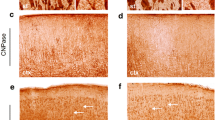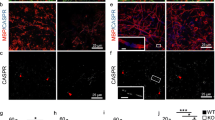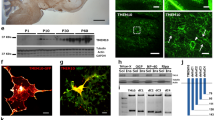Abstract
Most of the mutations within the PLP gene result in degeneration of oligodendrocytes and this is believed to be caused by intracellular trafficking defects. Previous studies have demonstrated that cells expressing the wild type PLP gene release a factor promoting differentiation/survival of oligodendrocyte and that this factor is the C-terminal portion of the protein itself. In this study we asked how the naturally occurring mutations of the PLP gene (jimpy, jimpy msd, and rumpshaker) affect this activity. We developed a transient expression system for retroviral production and transduction that enabled the expression of mutant PLP/DM20 cDNAs in NIH3T3 cells. None of the NIH3T3 cells producing mutant PLP/DM20s secreted the PLP-related factor that increases the number of oligodendrocytes. Since it has been shown that rumpshaker DM20 can be transported to the cell surface, but its folding is incorrect, absence of secretion of this factor is more heavily attributable to incorrect protein folding than to the defect in the PLP/DM20 trafficking.
Similar content being viewed by others
REFERENCES
Ikenaka, K., Kagawa, T., and Mikoshiba, K. 1992. Selective expression of DM-20, an alternatively spliced myelin proteolipid protein gene product, in developing nervous system and in nonglial cells. J. Neurochem. 58:2248–2253.
Timsit, S., Bally-Cuif, L., Colman, D. R., and Zalc, B. 1992. DM-20 mRNA is expressed during the embryonic development nervous system of the mouse. J. Neurochem. 58:1172–1175.
Nave, K.-A., Lai, C., Bloom, F. E., and Milner, R. J. 1987. Splice site selection in the proteolipid protein (PLP) gene transcript and primary structure of the DM-20 protein of central nervous system myelin. Proc. Natl. Acad. Sci. USA 84:5665–5669.
Mikoshiba, K., Okano, H., Tamura, T., and Ikenaka, K. 1991. Structure and function of myelin protein gene. Annu. Rev. Neurosci. 14:201–217.
Skoff, R. P. and Knapp, P. E. 1992. Phenotypic expression of X-linked genetic defects affecting myelination; in Myelin: Biology and Chemistry, (Martenson R. E. ed) pp. 653–676. Boca Raton, CRC Press.
Hodes, M. E. and Dlouhy, S. R. 1996. The proteolipid protein gene: double, double,... and trouble. Am. J. Genet. 59:12–15.
Lyon, M. F. 1972. X-Chromosome inactivation and developmental patterns in mammals. Biol. Rev. 47:1–35.
Benjamins, J. A., Studzinski, D. M., and Skoff R. P. 1986. Biochemical correlates of myelination in brain and spinal cord of mice heterozygous for the jimpy gene. J. Neurochem. 47:1857–1863.
Kagawa, T., Ikenaka, K., Inoue, Y., Kuriyama, S., Tsujii, T., Nakao, J., Nakajima, K., Aruga, J., Okano, H., and Mikoshiba, K. 1994. Glial cell degeneration and hypomyelination caused by overexpression of myelin proteolipid protein gene. Neuron 13:427–442.
Readhead, C., Schneider, A., Griffiths, I., and Nave, K.-A. 1994. Premature arrest of myelin formation in transgenic mice with increased proteolipid protein gene dosage. Neuron 12:583–595.
Schneider, A., Griffiths, I. R., Readhead, C., and Nave, K.-A. 1995. Dominant-negative action of the jimpy mutation in mice complemented with an autosomal transgene for myelin proteolipid protein. Proc. Natl. Acad. Sci. USA 92:4447–4451.
Gow, A., Friedrich, Jr. V. L., and Lazzarini, R. A. 1994. Many naturally occurring mutations of myelin proteolipid protein impair its intercellular transport. J. Neurosci. Res. 37:574–583.
Gow, A., Gragerov, A., Gard, A., Colman, D. R., and Lazzarini, R. A. 1997. Conservation of topology, but not conformation, of the proteolipid proteins of the myelin sheath. J. Neurosci. 17:181–189.
Gow, A., Southwood, C. M., and Lazzarini, R. A. 1998. Disrupted proteolipid protein trafficking results in oligodendrocyte apoptosis in an animal model of Pelizaeus-Merzbacher Disease. J. Cell Biol. 140:925–934.
Jung, M., Sommer, I., Schachner, M., and Nave, K. A. 1996. Monoclonal Antibody O10 defines a conformationally sensitive cell-surface epitope of proteolipid protein (PLP): Evidence that PLP misfolding underlies dysmyelination in mutant mice. J. Neurosci. 16:7920–7929.
Roussel, G., Neskovic, N. M., Trifilieff, E., Artault, J.-C., and Nussbaum, J.-L. 1987. Arrest of proteolipid transport through the Golgi apparatus in Jimpy brain. J. Neurocytol. 16:195–204.
Macklin, W. B., Campagnoni, C. W., Deininger, P. L., and Gardinier, M. V. 1987. Structure and expression of the mouse myelin proteolipid protein gene. J. Neurosci. Res. 18:383–394.
Nave, K.-A., Bloom, F. E., and Milner, R. J. 1987. A single nucleotide difference in the gene for myelin proteolipid protein defines the jimpy mutation in mouse. J. Neurochem. 49:1873–1877.
Moriguchi, A., Ikenaka, K., Furuichi, T., Okano, H., Iwasaki, Y., and Mikoshiba, K. 1987. The fifth exon of the myelin proteolipid protein-coding gene is not utilized in the brain of jimpy mutant mice. Gene 55:333–337.
Bartlett, W. F., Knapp, P. E., and Skoff, R. P. 1988. Glial conditioned medium enables jimpy oligodendrocyte to express properties of normal oligodendrocytes; Production of myelin antigens and membranes. Glia 1:253–259.
Lachapelle, F., Lapie, P., Campagnoni, A. T., and Gumpel, M. 1991. Oligodendrocytes of jimpy phenotype can be partially restored by environmental factors in vivo. J. Neurosci. Res. 29:235–243.
Nakao, J., Yamada, M., Kagawa, T., Kim, S. U., Miyao, Y., Shimizu, K., Mikoshiba, K., and Ikenaka, K. 1995. Expression of proteolipid protein gene is directly associated with serection of a factor influencing oligodendrocyte development. J. Neurochem. 64:2396–2403.
Knapp, P. E., William, P. B., Laura, A. W., Yamada, M., Ikenaka, K., and Skoff, R. 1999. Programmed cell death without DNA fragmentation in jimpy mouse: secreted factors can enhance survival. Cell Death Differ. 6:136–145.
Yamada, M., Ivanova, A., Yamaguchi, Y., Lees, M. B., and Ikenaka, K. 1999. PLP gene product can be secreted and exhibit biological activity during early development. J. Neurosci. 19:2143–2151.
Gencic, S. and Hudson, L. 1990. Conservative amino acid substitution in the myelin proteolipid protein of jimpymsd mice. J. Neurosci. 10:117–124.
Schneider, A., Montague, P., Griffiths, I. R., Fanarraga, M., Kennedy, P., Brophy, P., and Nave, K. A. 1992. Uncoupling of hypomyelination and glial cell death by a mutation in the proteolipid protein gene. Nature 358:758–761.
Yoshimatsu, T., Tamura, M., Kuriyama, S., and Ikenaka, K. 1998. Improvement of retroviral packaging cell lines by introducing the polyomavirus early region. Hum. Gene Ther. 9:161–172.
Ikeda, H., Yoshida, J., Yamada, H., Yoshimatsu, T., and Ikenaka, K. 1997. Retroviral introduction of the p16 gene into murine cell line to elicit marked antiproliferative effect. Jpn. J. Cancer Res. 88:712–717.
Bottenstein, J. E., Hunter, S. F., and Seidel, M. 1988. CNS neuronal cell line-derived factors regulated gliogenesis in neonatal rat brain cultures. J. Neurosci. Res. 20:291–303.
Sommer, I. and Schachner, M. 1981. Monoclonal antibodies (O1 to O4) to oligodendrocyte cell surfaces: An immunocytological study in the central nervous system. Develop. Biol. 83:311–327.
Yamamura, T., Konola, J. T., Wekerle, H., and Lees, M. B. 1991. Monoclonal antibodies against myelin proteolipid protein: Identification and characterization of two major determinants. J. Neurochem. 57:1671–1680.
Klugmann, M., Schwab, M. H., Pühlhofer, A., Schneider, A., Zimmeremann, F., Griffiths, I. R., and Nave, K.-A. 1997. Assembly of CNS myelin in the absence of proteolipid protein. Neuron 18:59–70.
Nixon, R. A. 1982. Increased axonal proteolysis in myelin-deficient mutant mice. Science 215:999–1001.
Griffiths, I., Klugmann, M., Anderson, T., Yool, D., Thomson, C., Schwab, M. H., Schneider, A., Zimmermann, F., McCulloch, M., Nadon, N., and Nave, K.-A. 1998. Axonal swelling and degeneration in mice lacking the major proteolipid of myelin. Science 280:1610–1613.
Author information
Authors and Affiliations
Rights and permissions
About this article
Cite this article
Yamada, M., Jung, M., Tetsushi, K. et al. Mutant PLP/DM20 Cannot Be Processed to Secrete PLP-Related Oligodendrocyte Differentiation/Survival Factor. Neurochem Res 26, 639–645 (2001). https://doi.org/10.1023/A:1010935203196
Issue Date:
DOI: https://doi.org/10.1023/A:1010935203196




